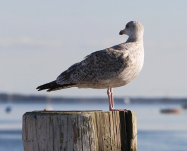CHAPTER 7 PROJECT
CHAPTER 7 PROJECT The Birds of Rügen Island

535
Let \(P=P(t)\) denote the population of rare birds on Rügen Island, where \( t\) is the time, in years. Suppose \(M\) equals the maximum sustainable number of birds and \(m\) equals the minimum population, below which the species becomes extinct. The population \(P\) can be modeled by the differential equation \[ \dfrac{\it dP}{dt}=k(M-P)(P-m) \]
where \(k\) is a positive constant.
- Suppose the maximum population \(M\) is 1200 birds and the minimum population \(m\) is 100 birds. If \(k=0.001\), write the differential equation that models the population \(P=P(t)\).
- Solve the differential equation from Problem 1. (Hint: \(\dfrac{ dP}{(M-P) (P-m) }=kdt;\) now integrate both sides and use partial fractions for the left integral.)
- If the population at time \(t=0\) is \(300\) birds, find the particular solution of the differential equation.
- How many birds will exist in \(5\) years?
- Using graphing technology, graph the solution found in Problem 3.
- The graph from Problem 5 seems to have an inflection point. Verify this and find it.
- What conclusions can you draw about the rate of change of population based on your answer to Problem 6?
- Write an essay about using the given differential equation to model the bird population. What assumptions are being made? What situations are being ignored?
- To watch a brief video, “Discover Germany: Rügen,” go to http://www.youtube.com/watch?v=E1Ra6QHLIt4
536